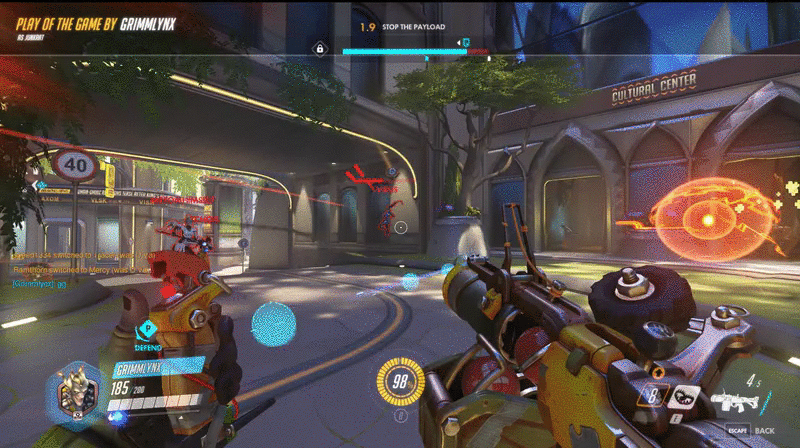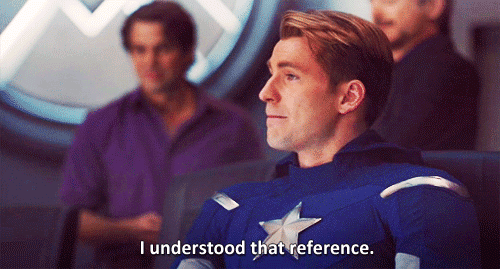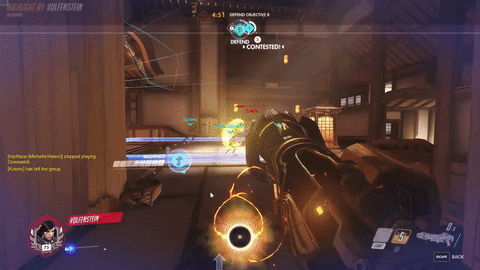The Cinematic, Life-Saving Sounds of Overwatch
Because a majority of our iconic video game characters were birthed during a time when visuals and gameplay were emphasized over story, they are primarily composed of a collection of distinguishing colors, movements, and, most importantly, sounds. Mario jumps like Mario, wears blue overalls and a red hat like Mario, but above all else, he sounds — from his voice#, to the cartoonish “sproing” of his hop# — like Mario. Pac-Man’s chomping sprees, whose visual design is about as simple as you can get, rely as much on their signature “waka-waka”# as Legend of Zelda does its “dun-na-na-nah!” pat-on-head when Link opens a chest.
Even if we’re not aware of it, as we tend to intermingle our senses when playing games, nostalgia doesn’t sweep over us with the visual, but with the aural:
Thus, when creating a new game — especially a paradigm-setting game like Blizzard’s Overwatch — the sound designers become the unsung heroes of the design team.
The newest addition to Blizzard Entertainment’s powerhouse roster of video games (you may know them for World of Warcraft or Hearthstone), Overwatch sets two online teams of various heroes against each other in first-person events like capturing objectives or escorting particularly important payloads.
All while a variety of bullets, bombs, lasers, and magical dragon spirits fly around them…

Initially, what strikes a player about Overwatch is the sheer diversity of play. Of the team-based shooter’s 21 characters available for play upon release, the super-soldier squad includes 10 men, 8 women, 2 robots, and a bespectacled gorilla, collectively representing a multitude of nationalities, races, bionic states, and sexual orientations. A short, squat female Chinese climatologist# battles the butch Russian bodybuilder Zarya# with a freeze-gun, while Japanese archer Hanzo jettisons arrow after arrow from a rooftop#. And from a design angle, every one of these eclectic characters feels completely different from the rest. The characters’ various backgrounds not only influence their in-game mechanics — a Brazilian DJ swaps empowered records to boost his teammates’ speed or heath regeneration#, a bi-pedal gatling gun plops down into a defensive sentry mode# — they’re reflected in the way they physically move across the map. The character with a jetpack launches and hovers, while others may skate, glide, or slowly rumble.
Still, having given the visuals and mechanics their due praise, it’s really Overwatch’s novel approach to the sound of its world — both compositionally addicting and instinctually scored — that make playing this game such a sensorially harmonious experience.

Less than a month out from its launch, Overwatch has already become a more immediately recognizable sonic reference than a decade of superheroes and countless video game predessecors. Its aural environment, complete with energy blasters rather than realistic rifles and larger-than-life footsteps, meets a YouTube-saturating soundtrack to become one of the first modern games since Halo’s choral orchestra or Team Fortress 2’s jazzy nostalgia to be a hit in the three sectors of gameplay, visuals, and sound.
From our first exposure to the universe, a 6-minute cinematic trailer, the score by Neal Acree, Derek Duke, and Cris Velasco announces the heroes with the kind of brassy pomp you’d reserve for something out of Marvel’s universe:
Bouncy, punchy, and regal, the main theme sounds like Holst’s Jupiter movement started its own spy agency.
The lone trumpet scales that introduce the menu screen are the same that announce its stars; the kind of catchy, immediately-recognizable uplift that is so utterly lacking in the weird pseudo-metal Iron Man theme or the self-congratulating haziness of The Avengers’.

Like the best John Williams, Overwatch boasts a deceptively simple, lovely, and cinematic soundtrack. Interlacing quiet moments with the mayhem – including memorable loading screens serving as stage introductions that give a small audio taste of the setting’s flavor# – creates a rich environment that brings a film-like narrative along with it, almost like Pixar’s wordless shorts. Instead of bashing us over the head with realistic battle racket, Overwatch’s sound team lets us embody heroes by embracing instinctual sound design while subtle, neoromantic musical motifs remind us of both our superhumanity and our community.
But while Overwatch’s score can keep you coming back, it’s its keen sound design that can increase your own…
The more you play Overwatch, becoming acutely familiar with the game and its playstyle, the more you depend on the sounds and the music to orient yourself within the game.
After a few quick deaths, you learn that you may not always see your opponent, instead leaning on the telltale hollow thunks of grenades leaving Junkrat’s launcher and the strident wooshes of Tracer’s Flash-like speed dash to help you stay alive. Additionally, many of the characters have Ultimate abilities that echo a map-wide announcement when executed – a combination of badass peacocking and early-warning device – so hearing Hanzo shout “RYUU GA WAGA TEKI WO KURAU!” means an instant eruption by teammates and opponents alike trying to pinpoint the location of the giant helixing dragons that will soon appear from the archer’s bow.
The same goes for the lawnmower-rev of Junkrat’s explosive Rip-Tire, or the now-completely-memed McCree’s dusty declaration of “High Noon”:
Overwatch’s characters are meant to be an outward expression of the game’s macro themes – the coming together of heroes and villains from every corner to do epic superhero combat – while its sounds do as much psychologically, beneath the surface, as they do when loud, brash, and global (affecting the entire game level).
The game literally trains our emotions with even its most basic sound effect: the “hit-pip” – the satisfying psst sizzle when your weapon, be it a sonic blaster or a sniper rifle, connects with an enemy.
That sizzle is actually derived from a modified version of a fizzy beer being opened, and what could be more subconsciously satisfying for a gamer than that bit of satisfying foley work? It’s an aural smiley face sticker every time your weapon connects. In lieu of something like Call of Duty’s realistic bullet noises, Overwatch encourages better aim through pleasing effects. Similarly, rather than Halo’s iconic low-health alarm indicator, Overwatch’s characters inhale sharply when taking severe damage, only to exhale after making it a certain time afterwards without dying.
Overwatch’s sound system also dynamically changes the volume of effects based on importance — who’s shooting whom, who’s in the most danger, who’s right behind you. Heavier enemies plod their footsteps as they attempt to sneak up on you, allowing for a hasty retreat or an ambush. Taking these factors into account, the game prioritizes sound effects to each player’s experience while hushing the rest. Dolby Atmos’s headphone surround sound will even eventually allow players to pinpoint enemies flying above or behind them by the sounds emitting from their rocket boots.

It’s this kind of subtle, near-subconsciously appreciated attention to aural detail that’s already hooked a legion of gamers who appreciate Overwatch as much as an ode to instinctual gameplay as they do for the visual feasts that might have first attracted them to the game originally.
More outwardly, the Overwatch online community has taken it upon itself to create joke after joke based on the “Play of the Game” segments that highlight a particularly impressive feat after each round commences. By replacing the game footage but keeping the game’s signature score, sound effects, and announcer, a meme had formed within days of the game’s release:
The crisp, evocative sounds Blizzard had created with Overwatch took on new life almost immediately.
Like what you read? Share it.
(That helps us.)
Love what you read? Patronize Jacob Oller.
That helps us and the writer.
What is Patronizing? Learn more here.


